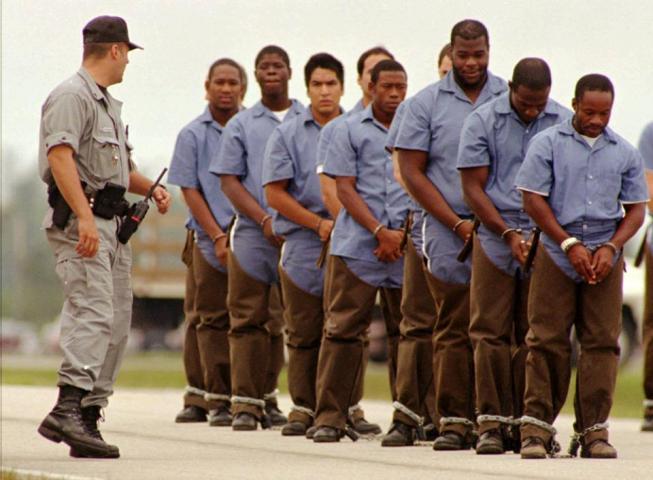How To End Prison Labor Exploitation And Invest In Incarcerated People

A group of inmates walk in leg chains under supervision on a road near the South Florida Reception… [+] Center, a maximum security prison, in Miami Tuesday, Nov. 21, 1995. (AP Photo/Daniel Portnoy)
On July 31, the California Department of Corrections tweeted, “Today, more than 2,000 volunteer inmate firefighters, including 58 youth offenders, are battling wildfire flames throughout CA. Inmate firefighters serve a vital role, clearing thick brush down to bare soil to stop the fire's spread.”
Fifty-eight youth battling wildfire flames.
In a practice that dates to the 1940s, California has 43 of these so-called adult conservation camps and one camp for juveniles. Incarcerated people in California contribute approximately three million hours annually responding to emergencies, and another seven million on community service, according to the state department of corrections website.
While California's policy of using incarcerated people as cheap labor is particularly egregious given the low wages—just $1 per hour and $2 per day—and the tremendous risk involved, the practice of having incarcerated people perform productive labor for negligible or no wages is indeed common across the United States.
A majority of the more than 1.5 million people in state and federal prisons work while they are incarcerated. The majority work in correctional industries, which are state-owned enterprises, and earn devastatingly low wages. Incarcerated people working in correctional industries earn an average of just 86 cents per hour.
Incarcerated people recognize low-wage prison labor as inherently exploitive. To protest poor prison conditions and unfair labor practices, incarcerated people across 17 states this week embarked on a national strike, making it the largest in the nation's history. Their demands include improving prison conditions; ending “prison slavery;” eliminating racial discrimination in the justice system; reinstating Pell grants for incarcerated people, and establishing voting rights for incarcerated people and returning citizens.
This is the third broad-based strike in as many years.
In 2016, an estimated 24,000 incarcerated workers across the country participated in a major strike to protest the use of prison labor. Earlier this year, incarcerated people across 10 Florida prisons went on strike.
States have argued that these programs save taxpayers money. The California Department of Corrections website, for example, notes that taxpayers see $100 million in savings as part of its firefighter program. Similarly, when the Iowa legislature earlier this year considered legislation to use prison workers to build low-income housing, policymakers pointed to potential cost savings and a low statewide unemployment rate, a tenuous justification for human exploitation.
Others have argued that incarcerated people benefit from prison labor programs as workforce development. However, it has been well-documented that these programs often do not lead to job opportunities. For example, returning citizens in California are often barred from becoming firefighters once they are released.
Given the incredibly low pay and poor working conditions, it is nearly impossible to avoid comparisons between prison labor programs of today and the ugly history of “convict leasing,” a policy of effectively renting out incarcerated people to private businesses that sprung up following the Civil War and endured until the late 1920s—only to be replaced by chain gangs. The comparison is particularly apt given the disproportionate rates of incarceration and overcriminalization among Black and Hispanic men and Black women.
While much of the public discourse on mass incarceration and criminal justice reform has focused on diversion and reentry, too little attention has been paid to what happens to people while they are incarcerated.
Because of systemic policy failures—including institutionalized racism—people who are incarcerated already have lower levels of educational attainment and are more likely to experience unemployment prior to incarceration. These challenges, combined with employment discrimination experienced by people with criminal records, can act as a significant barrier to employment upon release. This is particularly true among those who are Black and Hispanic.
Helping people who are incarcerated build their skills through education or training is therefore a worthwhile goal and one that enjoys significant support. According to a recent study, 70% of incarcerated people reported wanting to enroll in some academic program while incarcerated. Moreover, research shows that people who participate in corrections education and training services have much lower recidivism rates.
However, prison labor programs that offer only exploitation are not workforce development. These programs only further oppress people who are already living on the margins.
Policymakers should instead treat people who are incarcerated with dignity and reduce barriers to employment for those who will one day be released. That means paying decent wages, ensuring work programs are safe and truly voluntary, and expanding opportunities for high-quality education and training such as career pathways programs and apprenticeships that lead to jobs for returning citizens.
Striking workers across the country are courageously demanding these policy changes. We should listen.
This “Eyes on Trafficking” story is reprinted from its original online location.
 ABOUT PBJ LEARNING
ABOUT PBJ LEARNING
PBJ Learning is a leading provider of online human trafficking training, focusing on awareness and prevention education. Their interactive Human Trafficking Essentials online course is used worldwide to educate professionals and individuals how to recognize human trafficking and how to respond to potential victims. Learn on any web browser (even your mobile phone) at any time.
More stories like this can be found in your PBJ Learning Knowledge Vault.
EYES ON TRAFFICKING
This “Eyes on Trafficking” story is reprinted from its original online location.
ABOUT PBJ LEARNING
PBJ Learning is a leading provider of online human trafficking training, focusing on awareness and prevention education. Their interactive Human Trafficking Essentials online course is used worldwide to educate professionals and individuals how to recognize human trafficking and how to respond to potential victims. Learn on any web browser (even your mobile phone) at any time.
More stories like this can be found in your PBJ Learning Knowledge Vault.
